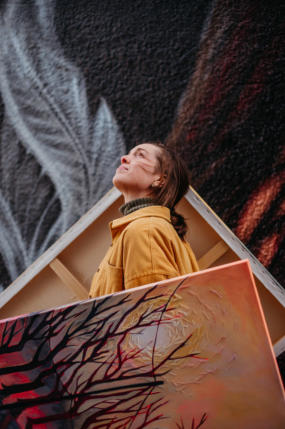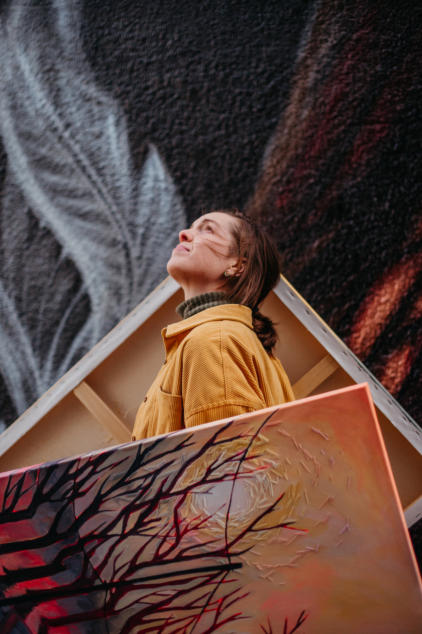CURRENT EXHIBITS


Always Back to Nevada:
Craig Sheppard and art at the
University of Nevada, Reno
On view in Halleck Bar Gallery until April 26, 2026
While a quintessential Nevada artist, a lot of what influenced Craig
Sheppard (1913-1978) originates from his upbringing in Oklahoma.
Craig Sheppard was born in Lawton, Oklahoma, in 1913. He learned
about hunting, ranching, and riding from his Texas-born father and was
taught how to paint by his mother. With an upbringing full of contrasts,
it is no wonder that the artist worked with many media including oil,
watercolor, and Japanese brush painting, and creatively bounced from
genre to genre, expressing himself through realism, abstraction, and
cubist-like sensibilities.
Craig Sheppard arrived in Reno, Nevada in 1947, joining the Art
Department at the University of Nevada Reno. He is credited with building the department from scratch, enlarging facilities, improving the quality of
instruction, and initiating a program of exhibitions which brought the works of major artists to the campus and community. He was the founding
collector of what became known as the Sheppard Gallery at UNR.
The Lilley Museum of Art was opened in 2019 and now houses the collection started and cultivated by Sheppard. The works in the museum
collection demonstrate Craig Sheppard’s experimental approach to art making and his prolific and diverse output.
Sheppard varied his style throughout his career. Following extended trips to Norway (1956) and France (1961), he drew inspiration from the modernist
painters in Europe and experimented with Cubism and abstraction. But upon his return stateside, the artist seemed to always return to familiar subject
matter that denoted a love of his homeland: the vast deserts of Nevada, contemplative narratives of cowboys on horseback, at work or in repose, and
horses on the range. This exhibition demonstrates the constant oscillation between styles and the exciting results of constant experimentation.
On July 27, 1978, an editorial on Craig Sheppard in the Nevada State Journal noted that: “One person who never stayed in a box, and who, as a result,
influenced the entire community…”[Sheppard is] “probably the most important visual artist dealing in Nevada themes…a unique combination of the
sophisticated academician and the salty pioneer prospector.”
—Stephanie Gibson, Director, Lilley Museum of Art

Caro Nilsson
For Those Who Bear Witness
On view in Barrick Gallery until December 14, 2025
There are many ways I can think of that love looks like. Sometimes it looks like a garden tomato, a shared meal,
or sometimes it looks like a postcard in the mail. Sometimes it looks like the tracks that snails left for us overnight on
sidewalks or sacred datura opening for the moon. Sometimes it looks the way a trail in the forest does—a collection of
anonymous shared footprints that go somewhere that many somebodies thought was special. Sometimes it looks the way
the sky does once it finishes raining. Sometimes it looks like stopping to look around to say ‘wow’. Sometimes, it looks
like this.
To me, love always looks like remembering our communities, communities that are so much broader than just our
human neighbors. In the beloved Basin, here, the community is the boulders and the scrub oaks, the cliffs, the meadow
on the mountaintop, the vast remainder of the inland ocean that we call the Great Salt Lake. The seagulls, the
snakes. The owls, the mountain lions. Love looks like remembering that we are a tiny part of a big, unknowable
something. Love looks like continuing to care, continuing to bear witness, even when it is hard.
At this moment, we are watching as an era unfolds. Wildfires, inversion, dust storms—all these things obscure the
air, hiding landscapes (our context, our home) within them. We are unable to see into the distance, to think about time
and space and infinite chances. The world as we know it is condensed to a bubble of our immediate surroundings. As
we acknowledge our changing landscapes, we must also acknowledge our grief. These paintings are asking what it feels
like to hold grief and hope simultaneously alongside one another. These paintings ask if perhaps they are the same thing, two sides of the same coin. Can we continue to walk
during the slow motion unfolding (despite, in spite) and continue to bear witness with all of our grief and all of our hope? Can we remember that we are small among the
ancient others who bear witness alongside us?
—Caro Nilsson
Caro’s dream-like landscapes pull the viewer into a specific place that feels outside of time. Gestural marks eddy beneath swaths of color-shift or
tactile embroidery thread. Her paintings straddle the line between real and imaginary—understanding the notion that everything is always both. Caro
paints primarily from memory, focusing more on the way a place felt than how it may have actually looked. In this way, memory morphs and
heightens the shapes, shadows, and colors of her landscape blurring the facts in a way that feels more honest and true to the experience that it came
from. At its heart, Caro’s work is about a personal relationship with landscapes and all the human and non-human influences and presences within
them.
Rooted in traditions of impressionism, Caro’s paintings depict worlds in which the act of observation (beyond just that of sight) plays a role in their
creation. By simply noticing magic within the mundane, the world that we live in becomes full of mystery and excitement, a world of hidden stories
meant to be uncovered by those who take the time to listen.
Caro was born in Vancouver, Washington on April 14, 1993, and has spent her entire life building relationships with the land in America’s endlessly
variable biomes and translating those feelings and findings into paintings. She holds a B.A. in Fine Art with a Distinguished Major in Printmaking and
a B.S. in Architecture from the University of Virginia. She currently lives as a multi-media painter and muralist, painting full time from Salt Lake City.


CURRENT EXHIBITS

Always Back to Nevada:
Craig Sheppard and art at the
University of Nevada, Reno
On view in Halleck Bar Gallery until April 26, 2026
While a quintessential Nevada artist, a lot of what influenced
Craig Sheppard (1913-1978) originates from his upbringing in
Oklahoma. Craig Sheppard was born in Lawton, Oklahoma, in
1913. He learned about hunting, ranching, and riding from his
Texas-born father and was taught how to paint by his mother. With
an upbringing full of contrasts, it is no wonder that the artist
worked with many media including oil, watercolor, and Japanese
brush painting, and creatively bounced from genre to genre,
expressing himself through realism, abstraction, and cubist-like
sensibilities.
Craig Sheppard arrived in Reno, Nevada in 1947, joining the Art
Department at the University of Nevada Reno. He is credited with
building the department from scratch, enlarging facilities, improving
the quality of instruction, and initiating a program of exhibitions
which brought the works of major artists to the campus and
community. He was the founding collector of what became known
as the Sheppard Gallery at UNR.
The Lilley Museum of Art was opened in 2019 and now houses
the collection started and cultivated by Sheppard. The works in the
museum collection demonstrate Craig Sheppard’s experimental
approach to art making and his prolific and diverse output.
Sheppard varied his style throughout his career. Following extended
trips to Norway (1956) and France (1961), he drew inspiration from
the modernist painters in Europe and experimented with Cubism
and abstraction. But upon his return stateside, the artist seemed to
always return to familiar subject matter that denoted a love of his
homeland: the vast deserts of Nevada, contemplative narratives of
cowboys on horseback, at work or in repose, and horses on the
range. This exhibition demonstrates the constant oscillation
between styles and the exciting results of constant experimentation.
On July 27, 1978, an editorial on Craig Sheppard in the Nevada State
Journal noted that: “One person who never stayed in a box, and
who, as a result, influenced the entire community…”[Sheppard is]
“probably the most important visual artist dealing in Nevada
themes…a unique combination of the sophisticated academician
and the salty pioneer prospector.”
—Stephanie Gibson, Director, Lilley Museum of Art

Caro Nilsson
For Those Who Bear Witness
On view in Barrick Gallery until December 14, 2025
There are many ways I can think of that love looks like. Sometimes it looks
like a garden tomato, a shared meal, or sometimes it looks like a postcard in the
mail. Sometimes it looks like the tracks that snails left for us overnight on
sidewalks or sacred datura opening for the moon. Sometimes it looks the way a
trail in the forest does—a collection of anonymous shared footprints that go
somewhere that many somebodies thought was special. Sometimes it looks the
way the sky does once it finishes raining. Sometimes it looks like stopping to
look around to say ‘wow’. Sometimes, it looks like this.
To me, love always looks like remembering our communities, communities that
are so much broader than just our human neighbors. In the beloved Basin, here,
the community is the boulders and the scrub oaks, the cliffs, the meadow on the
mountaintop, the vast remainder of the inland ocean that we call the Great Salt
Lake. The seagulls, the snakes. The owls, the mountain lions. Love looks like
remembering that we are a tiny part of a big, unknowable something. Love
looks like continuing to care, continuing to bear witness, even when it is hard.
At this moment, we are watching as an era unfolds. Wildfires, inversion, dust
storms—all these things obscure the air, hiding landscapes (our context, our
home) within them. We are unable to see into the distance, to think about time
and space and infinite chances. The world as we know it is condensed to a bubble
of our immediate surroundings. As we acknowledge our changing landscapes, we
must also acknowledge our grief. These paintings are asking what it feels like to
hold grief and hope simultaneously alongside one another. These paintings ask if
perhaps they are the same thing, two sides of the same coin. Can we continue to
walk during the slow motion unfolding (despite, in spite) and continue to bear
witness with all of our grief and all of our hope? Can we remember that we are
small among the ancient others who bear witness alongside us?
—Caro Nilsson
Caro’s dream-like landscapes pull the viewer into a specific place
that feels outside of time. Gestural marks eddy beneath swaths of
color-shift or tactile embroidery thread. Her paintings straddle the
line between real and imaginary—understanding the notion that
everything is always both. Caro paints primarily from memory,
focusing more on the way a place felt than how it may have actually
looked. In this way, memory morphs and heightens the shapes,
shadows, and colors of her landscape blurring the facts in a way that
feels more honest and true to the experience that it came from. At
its heart, Caro’s work is about a personal relationship with
landscapes and all the human and non-human influences and
presences within them.
Rooted in traditions of impressionism, Caro’s paintings depict
worlds in which the act of observation (beyond just that of sight)
plays a role in their creation. By simply noticing magic within the
mundane, the world that we live in becomes full of mystery and
excitement, a world of hidden stories meant to be uncovered by
those who take the time to listen.
Caro was born in Vancouver, Washington on April 14, 1993, and
has spent her entire life building relationships with the land in
America’s endlessly variable biomes and translating those feelings
and findings into paintings. She holds a B.A. in Fine Art with a
Distinguished Major in Printmaking and a B.S. in Architecture from
the University of Virginia. She currently lives as a multi-media
painter and muralist, painting full time from Salt Lake City.
















